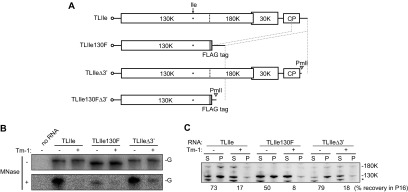Fig 4.

Negative-strand RNA synthesis is not required for the sequestration of ToMV RNA in the membranous compartment or NaCl-resistant membrane binding of the 130K protein. (A) Schematic representation of ToMV RNA derivatives used in Fig. 4 and 5. TLIle130F lacks the read-through region of the 180K polymerase, the 30K protein-coding region, and the 5′ half of the coat protein (CP)-coding region. TLIleΔ3′ is a transcript from a PmlI-linearized plasmid carrying full-length TLIle cDNA and lacks the 3′-terminal 158-nucleotide sequence. TLIle130FΔ3′ is a transcript from a PmlI-linearized plasmid encoding TLIle130F. (B) The read-through region for the 180K protein and the 3′ UTR of ToMV RNA are not required for the nuclease resistance of the genome RNA. 32P-labeled TLIle, TLIle130F, and TLIleΔ3′ RNAs were used as translation templates and analyzed as for Fig. 3. (C) The read-through region for the 180K protein and the 3′ UTR of ToMV RNA are not required for the 130K protein to bind membranes in a 0.5 M NaCl-resistant manner. TLIle, TLIle130F, and TLIleΔ3′ RNAs were translated in mdBYL, incubated with mdBYL from Tm-1-expressing (+) or -nonexpressing (−) BY-2 cells, and then incubated with BYL membranes. After incubation, membrane-containing pellets were prepared by centrifugation at 16,000 × g, suspended in 0.5 M NaCl-containing buffer, and centrifuged again at 16,000 × g to obtain the supernatant (S) and pellet (P) fractions. ToMV replication proteins in each fraction were detected by Western blotting and quantified with a LAS-3000 (Fujifilm, Japan). A typical set of results is shown, and the percentages of the 130K protein recovered in the P16 fractions are indicated. The asterisk represents background signals.
